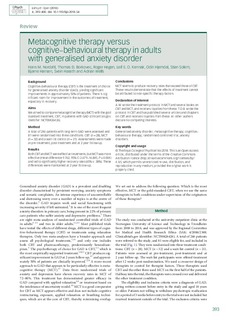| dc.contributor.author | Nordahl, Hans Morten | |
| dc.contributor.author | Borkovec, Thomas D | |
| dc.contributor.author | Hagen, Roger | |
| dc.contributor.author | Kennair, Leif Edward Ottesen | |
| dc.contributor.author | Hjemdal, Odin | |
| dc.contributor.author | Solem, Stian | |
| dc.contributor.author | Hansen, Bjarne | |
| dc.contributor.author | Haseth, Svein | |
| dc.contributor.author | Wells, Adrian | |
| dc.date.accessioned | 2019-01-03T08:33:08Z | |
| dc.date.available | 2019-01-03T08:33:08Z | |
| dc.date.created | 2018-10-03T11:26:16Z | |
| dc.date.issued | 2018 | |
| dc.identifier.citation | BJPsych Open. 2018, 4 (5), 393-400. | nb_NO |
| dc.identifier.issn | 2056-4724 | |
| dc.identifier.uri | http://hdl.handle.net/11250/2578858 | |
| dc.description.abstract | Background
Cognitive–behavioural therapy (CBT) is the treatment of choice for generalised anxiety disorder (GAD), yielding significant improvements in approximately 50% of patients. There is significant room for improvement in the outcomes of treatment, especially in recovery.
Aims
We aimed to compare metacognitive therapy (MCT) with the gold standard treatment, CBT, in patients with GAD (clinicaltrials.gov identifier: NCT00426426).
Method
A total of 246 patients with long-term GAD were assessed and 81 were randomised into three conditions: CBT (n = 28), MCT (n = 32) and a wait-list control (n = 21). Assessments were made at pre-treatment, post-treatment and at 2 year follow-up.
Results
Both CBT and MCT were effective treatments, but MCT was more effective (mean difference 9.762, 95% CI 2.679–16.845, P = 0.004) and led to significantly higher recovery rates (65% v. 38%). These differences were maintained at 2 year follow-up.
Conclusions
MCT seems to produce recovery rates that exceed those of CBT. These results demonstrate that the effects of treatment cannot be attributed to non-specific therapy factors. | nb_NO |
| dc.language.iso | eng | nb_NO |
| dc.publisher | Cambridge University Press | nb_NO |
| dc.rights | Navngivelse 4.0 Internasjonal | * |
| dc.rights.uri | http://creativecommons.org/licenses/by/4.0/deed.no | * |
| dc.title | Metacognitive therapy versus cognitive–behavioural therapy in adults with generalised anxiety disorder | nb_NO |
| dc.type | Journal article | nb_NO |
| dc.type | Peer reviewed | nb_NO |
| dc.description.version | publishedVersion | nb_NO |
| dc.source.pagenumber | 393-400 | nb_NO |
| dc.source.volume | 4 | nb_NO |
| dc.source.journal | BJPsych Open | nb_NO |
| dc.source.issue | 5 | nb_NO |
| dc.identifier.doi | 10.1192/bjo.2018.54 | |
| dc.identifier.cristin | 1617520 | |
| dc.description.localcode | © The Royal College of Psychiatrists 2018 This is an Open Access article, distributed under the terms of the Creative Commons Attribution licence (http://creativecommons.org/licenses/by/4.0/), which permits unrestricted re-use, distribution, and reproduction in any medium, provided the original work is properly cited. | nb_NO |
| cristin.unitcode | 194,65,35,0 | |
| cristin.unitcode | 194,67,40,0 | |
| cristin.unitname | Institutt for psykisk helse | |
| cristin.unitname | Institutt for psykologi | |
| cristin.ispublished | true | |
| cristin.fulltext | original | |
| cristin.qualitycode | 1 | |

